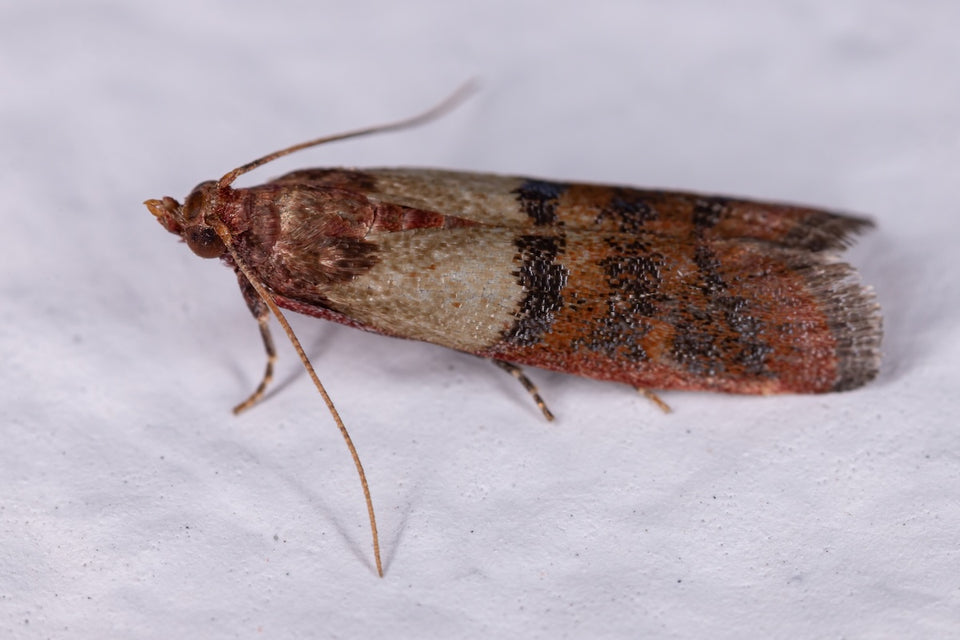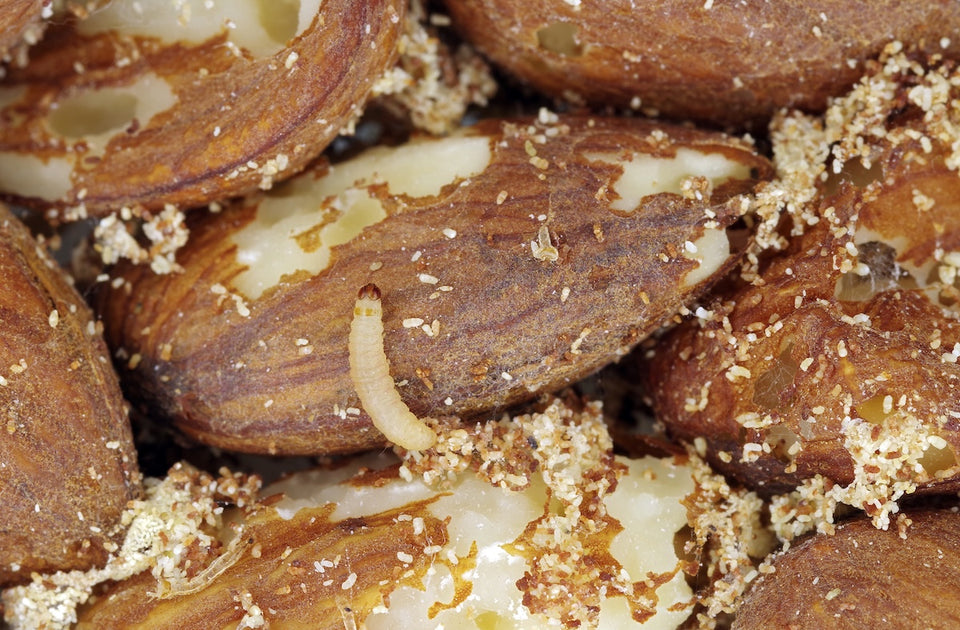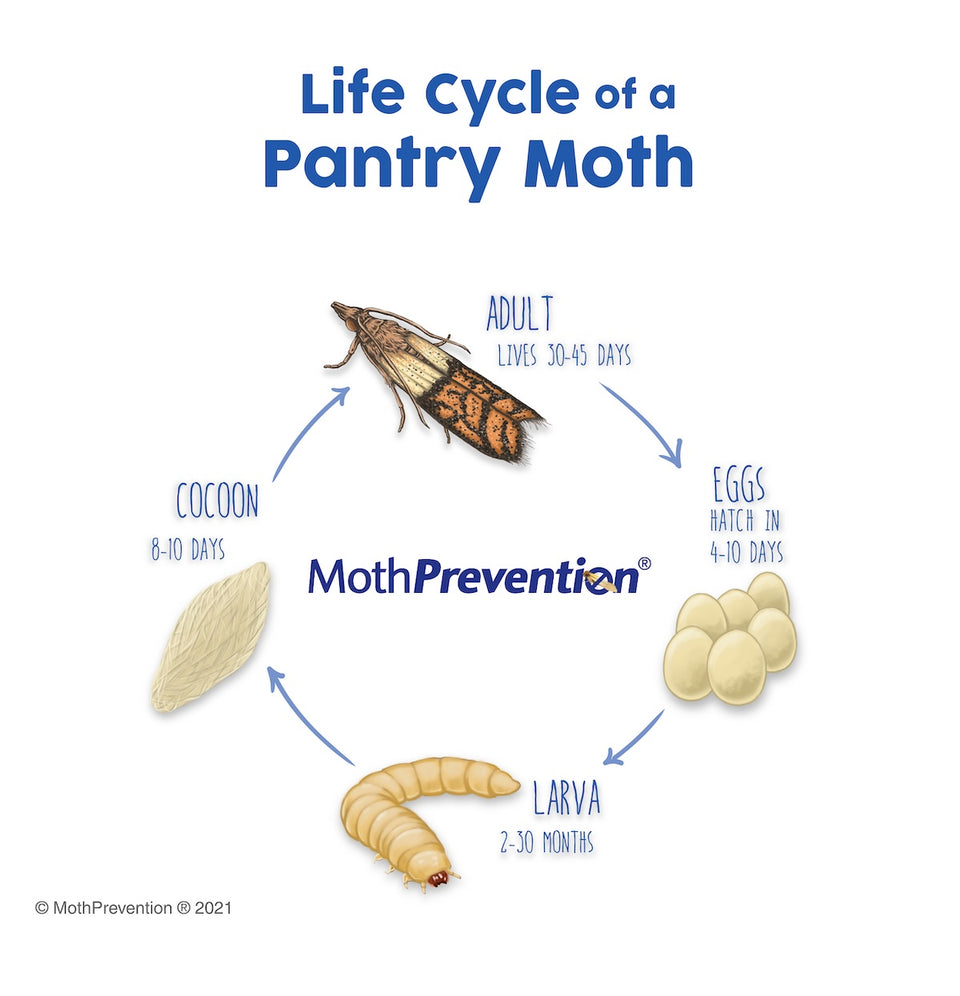How to Get Rid of Pantry Moths for Good: Step-by-Step Guide

Pantry Moths are one of the most frustrating household pests. These small, seemingly harmless insects can quickly take over cupboards, contaminating food and leaving behind webbing and larvae that make food products unsafe to eat. Once established, a Pantry Moth infestation can feel relentless, but with the right approach, you can not only remove them but also prevent them from coming back.
Understanding Pantry Moths
The species most commonly found in homes is the Indian Meal Moth (Plodia interpunctella). These moths are small, around 1 cm long, with brown or grey wings and a distinctive two-tone pattern. While the adult moths are what you are most likely to notice fluttering around your kitchen, they are not the real problem. It is their larvae that cause the damage. Adult females lay eggs directly onto food sources, and once the eggs hatch, the larvae feed on dry goods until they are ready to pupate and emerge as new moths.
Pantry Moth Larvae are not picky eaters. They thrive on flour, rice, pasta, cereals, nuts, dried fruit, chocolate, herbs, spices, pet food, and even bird seed. Their ability to feed on such a wide variety of goods is one of the reasons infestations can spread so quickly. All it takes is one contaminated package from the supermarket to introduce hundreds of eggs into your home.
How to Identify a Pantry Moth Infestation

The early signs of a Pantry Moth infestation are often subtle. You might notice a few adult moths flying near cupboards or hovering around the ceiling. A closer inspection of dry goods can reveal webbing, clumping, or small cream-coloured larvae. In flour or grains, larvae can bind particles together, creating hard lumps. Some homeowners also notice a stale or musty smell coming from infested food products.
Because Pantry Moths reproduce quickly, failing to act immediately can allow the infestation to multiply. A single female moth can lay up to 500 eggs during their lifespan, and these eggs can hatch in just a few days if the environment is warm. Within weeks, an isolated problem can turn into a widespread infestation.
Step One: Empty and Inspect Everything
The first step in getting rid of Pantry Moths is to completely empty your cupboards and food storage areas. Every item must be checked, even if it appears untouched. Pantry Moth Larvae are small and can burrow into the corners of packaging where they are easily overlooked. If you find webbing, larvae, or an unusual smell, the item should be disposed of immediately. Place it in a sealed bag and take it outside to the bin so that larvae cannot escape and re-infest your kitchen.
Even food that looks unaffected should be carefully examined. Thin packaging such as paper or cardboard is easily penetrated by larvae. If in doubt, it is safer to discard questionable items than risk the infestation continuing.

Step Two: Deep Clean the Cupboards
Once cupboards are cleared, a meticulous cleaning process is essential. Vacuum every shelf and crevice, paying attention to corners, joins, and edges where eggs might be hidden. Do not forget to vacuum the floor beneath cupboards and the gaps between appliances, as larvae can travel surprisingly far in search of food.
After vacuuming, wash every surface with a mild detergent. Shelf liners should be replaced or thoroughly cleaned, and reusable containers should be scrubbed in hot, soapy water before being refilled.
Step Three: Store Food in Airtight Containers
Proper food storage is one of the most powerful defences against Pantry Moths. Once your cupboards are cleaned, transfer all dry goods into airtight containers made of glass, heavy plastic, or metal. Pantry Moth Larvae are capable of chewing through thin cardboard and even some types of plastic packaging, so supermarket packaging is rarely sufficient.

Step Four: Use Pantry Moth Traps
Even after the most thorough cleaning, it is still possible for a few moths to survive. That is why Pantry Moth Traps are so important. These traps use a harmless attractant to draw in adult male moths, reducing their ability to breed and providing a clear indication of whether the infestation has truly been dealt with.
Traps should be placed inside cupboards, near dry goods, and around other food storage areas. They should remain active for at least several weeks, and ideally longer, to ensure that no new moths emerge undetected. Replace traps every eight weeks, or sooner if they become dusty or full.
Step Five: Persistence Breaks the Cycle
The key to successfully eliminating Pantry Moths is persistence. Because the life cycle includes eggs, larvae, pupae, and adults, it can take several weeks to fully eradicate an infestation. Even after an initial deep clean, you may still notice a few adult moths appearing. This is normal, as hidden pupae can emerge after cleaning.
Continue to monitor with traps, keep food in airtight containers, and repeat inspections regularly for at least one to two months. Over time, the moth population will diminish as their breeding cycle is disrupted and food sources are removed.

Long-Term Prevention
Once the infestation is gone, preventative measures are crucial to keeping your kitchen moth-free. Regularly rotate food so that items do not sit undisturbed for long periods. Avoid buying more than you can reasonably consume in a few months unless you have proper airtight storage. Clean cupboards thoroughly at least twice a year and inspect any new food purchases, particularly bulk grains, nuts, or pet food. Do not leave poorly packaged or exposed foodstuffs in your food storage areas.
Using Pantry Moth Traps year-round is a smart preventative step. These traps not only monitor for new infestations but also provide peace of mind that your kitchen remains protected.
Final Thoughts
Pantry Moths are persistent pests, but with a structured approach—identifying the problem, deep cleaning, storing food correctly, and using monitoring traps—you can eliminate them and keep them from coming back. A single contaminated packet may introduce the problem, but with consistent vigilance, airtight storage, and traps in place, you can protect your food supply and keep your kitchen secure for good.

About MothPrevention
MothPrevention® speak to customers every day about their clothes moth issues - clothes moths are a species that are ever increasing and that can cause significant damage to clothes, carpets and other home textiles.
To date, we’ve helped over 250,000 customers deal with their moth problems. We have developed professional grade solutions including proprietary pheromones and trap design, not available from anybody else in the USA.





